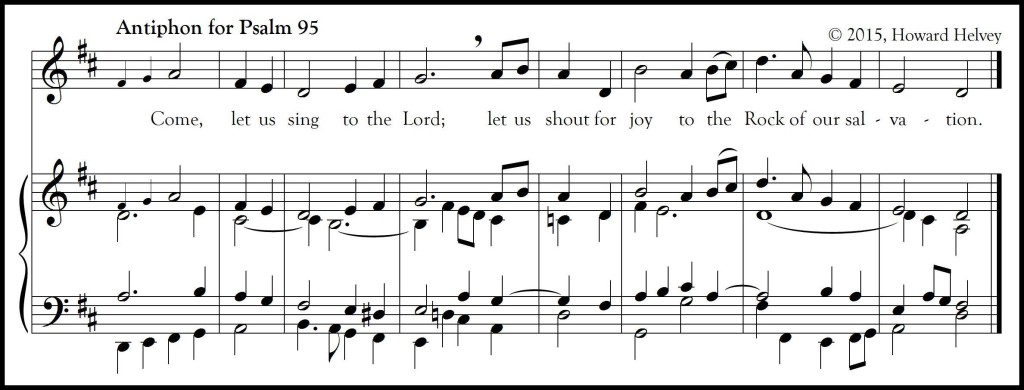
Introduction and Background
Calvary Episcopal Church in Cincinnati (in the specific historic community of Clifton), founded in 1856, has a long, respected tradition of music and the arts—including fervent congregational singing. Initiated at the invitation from Calvary’s rector, the Reverend Jason Leo, in the summer of 2011, I was excited and grateful (and a bit fearful) to take on the task of composing a weekly organ-accompanied, unison-voice antiphon for the appointed psalm or canticle each Sunday and Holy Day within the three-year cycle of the Revised Common Lectionary.
Since beginning in 1998 as organist/choirmaster, Calvary’s congregation and choir have weekly sung the psalms in a variety of ways: monotone, plainchant, metrical paraphrase, responsorial, simplified Anglican chant, and traditional Anglican chant. The most common method currently, however, involves the choir singing the psalm to Anglican chant with the congregation responding at various intervals with a repeated antiphon/refrain. Thus, this collection represents the fruit of that three-year project.
The aptitude and vocal range of an engaged congregation was in mind during the creation of each antiphon. Many of the antiphons can be sung easily within a single breath; others require two or (very rarely) three. Care was given to ensure that the words are carried naturally by the melody, with concurrent textual and musical stresses (sometimes resulting in gentle mixed meter), a degree of text painting, and “tall,” stressed vowels often living on a relatively medium-high pitch—or within a melisma. No time signatures are shown, nor specific tempi. It is my hope that the latter is instinctively felt by the construction of each antiphon itself: the harmonic rhythm, phrase length(s), natural tendencies of the text, and general mood.
The melody-only version generally should suffice for congregational bulletins, but the antiphons ideally should be accompanied using the version with the organ part. A very brief introduction/intonation is provided for each antiphon in order to quickly establish tempo, key, dynamic, starting pitch, and perhaps even style. The introduction also makes it easily possible to intersperse a sung antiphon amid a spoken psalm or canticle.
In determining the brief antiphon text for each of the appointed psalms and canticles, consideration was given to the overarching theme or idea that was being conveyed. Often that textual phrase ended up being a literal part of the appointed psalm or canticle itself, but sometimes words borrowed from a different psalm seemed like the best choice. The text for each antiphon comes from the 1979 Episcopal Book of Common Prayer (public domain).
Our use of the antiphons at Calvary Episcopal Church required their recurrence to integrate with the specific Anglican Chant I selected for the body of each psalm or canticle text, so attention to key, character and style were considered during each antiphon’s creation. The resulting chant/antiphon pairing became a unique setting of the psalm for us at Calvary. The antiphons herein are shown individually without the environment of Anglican Chant and pointed psalms.
While these refrains were intended to integrate effectively within the context of Anglican Chant, they can also be interspersed with other methods of singing the psalms. For example, the tonic or dominant pitch of a particular antiphon can be used as a reciting tone for the psalm/canticle text body. In the oldest known use of antiphons, they were sung immediately prior to and following the whole psalm or canticle. In more recent times, antiphons often are distributed more frequently within the body of the full text. Care should be taken, of course, to make sure that a satisfying balance is found, and that the antiphon never creates an awkward “bump” in a linear narrative or thought.
As there are recurring general subjects and tenets throughout the psalms, a few of the antiphons appear more than once. For certain psalms, two antiphon options are presented. And to accommodate the breadth of themes throughout Psalm 119, several antiphons were composed. In a few instances, the same antiphon is presented in two keys. And in three cases, a short, optional treble descant is included.
Conditions for Reprinting
As of June 2015, the complete set of antiphons is pending external publication. To be alerted of updates and availability, please complete the form found below.
Sample Pages
To view sample pages of the Clifton Antiphons, click here.